The fingers on both hands aren’t enough to count the seriously frightening tremors I’ve experienced in my 29 years in Taiwan.
The scariest was the 921 Earthquake, which shook the entire country in the early hours of Sept. 21, 1999. The second most terrifying was the earthquake that woke me and countless other Tainan residents up before dawn on Feb. 6, 2016.
Tomorrow will be the fifth anniversary of the disaster, which killed 117 people, all but two of them in a single apartment complex.
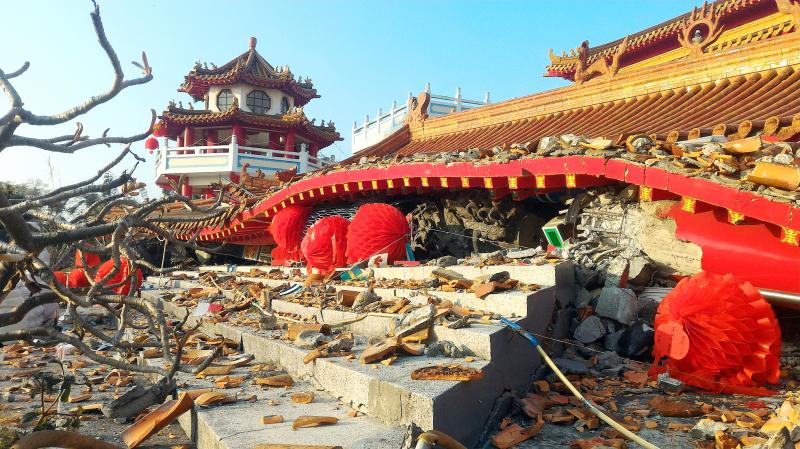
Photo: Steven Crook
After the earthquake struck, I couldn’t get back to sleep. The house I share with my wife and son suffered a power cut. Checking the property over with a flashlight, I discovered that our only material loss was a drinking glass. It had rolled off the living room table and shattered.
COLLAPSED BUILDINGS
On social media, I saw photos of a partly-collapsed building a few kilometers from my home. I recognized it straight away. It’s the tallest structure in that neighborhood, and well before the disaster it had piqued my curiosity, because floors three to 10 had obviously never been occupied.
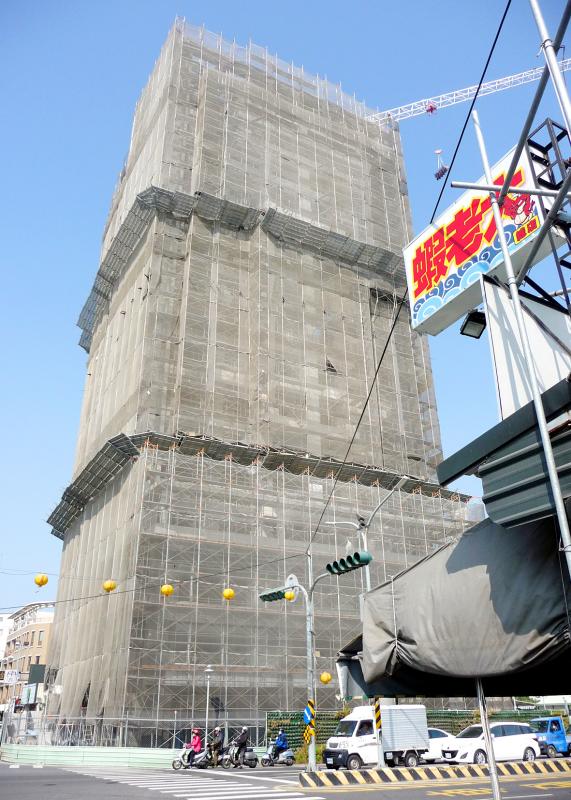
Photo: Steven Crook
An hour after dawn, I walked into the center of Sinhua District (新化) to take a closer look. When I got close to the heavily tilting block, I heard one person say to another that it’d been completed just before 921, but afterward was deemed unsafe for habitation. I’ve never been able to confirm this explanation.
The collapse squashed a bank branch on the first and second floors. Military policemen, some holding assault rifles, ringed the site, just in case criminals attempted to excavate the bank’s vault.
Over the following days, I saw the building slowly demolished. The bank eventually returned to a new structure on the plot. Modest in terms of size, it’s quite stylish by the standards of old Sinhua.
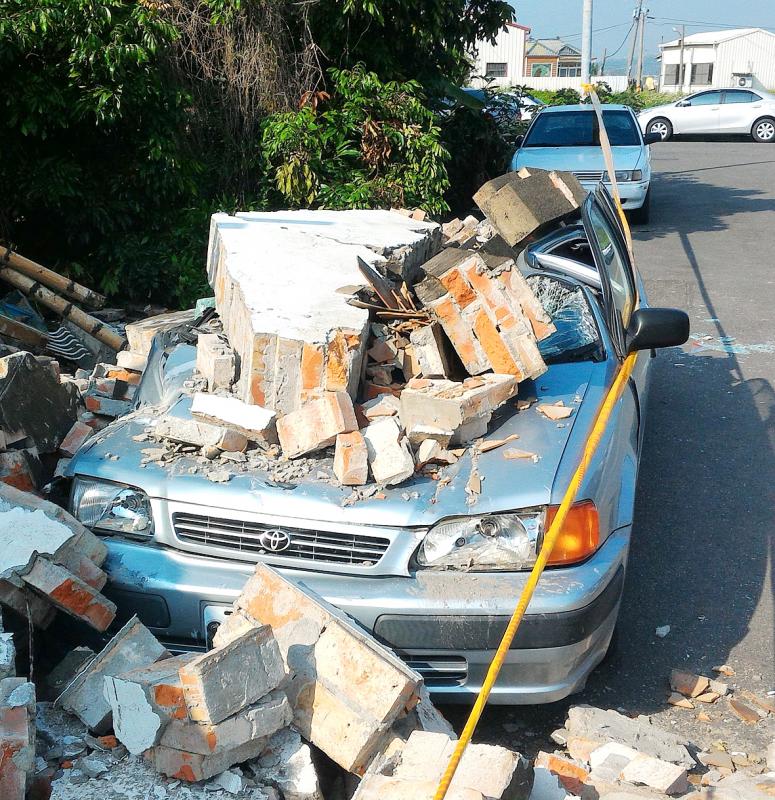
Photo: Steven Crook
Later that morning, outside a fallen-down factory annex in Yongkang District (永康), a Filipino man told me that, if the quake had struck during the day, it would’ve come down on top of him and his coworkers.
Over the next few days, I saw destruction at several more locations around Tainan — and lost count of the bicycles, motorcycles, and cars wrecked by toppled walls. Neighbors and acquaintances had to make do without running water because their rooftop tanks had come down in the quake.
One especially memorable sight was in Guanmiao (關廟), where not one of the 16 columns that had held up the front pavilion of Sitai Cihui Temple (西台慈惠堂) still stood. The shrine’s managers later told the sister newspaper of the Taipei Times, the Liberty Times, that rebuilding the pavilion and repairing other damage would cost an estimated NT$15 million, and that they’d no idea how they’d get the money.
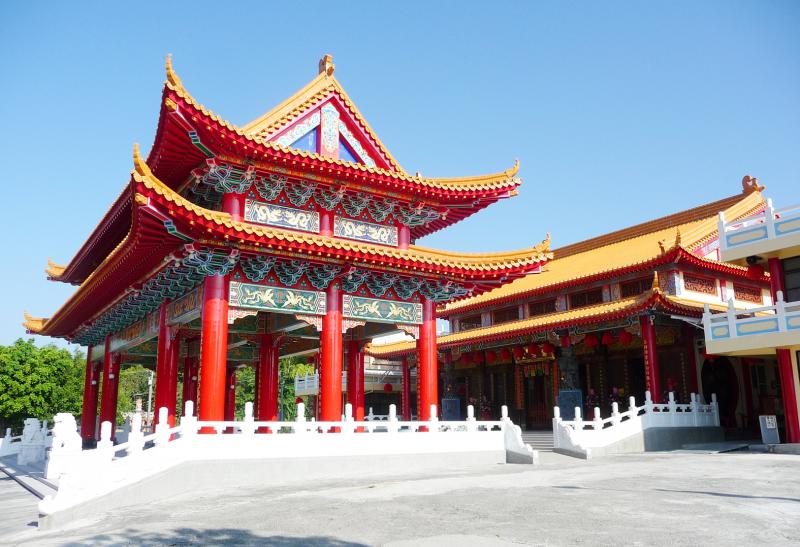
Photo: Steven Crook
TOURING THE “206” SITES
Late last month, I kicked off a tour of “206” sites by returning to Sitai Cihui Temple, where the principal deity is the Queen Mother of the West (西王母, sometimes called 王母娘娘).
The temple is located on the western edge of Shenkeng (深坑), a village on both sides of Highway 19A (19甲). Visitors approaching from the north should look for the km50.5 marker, then for a sign on the right pointing to the temple.
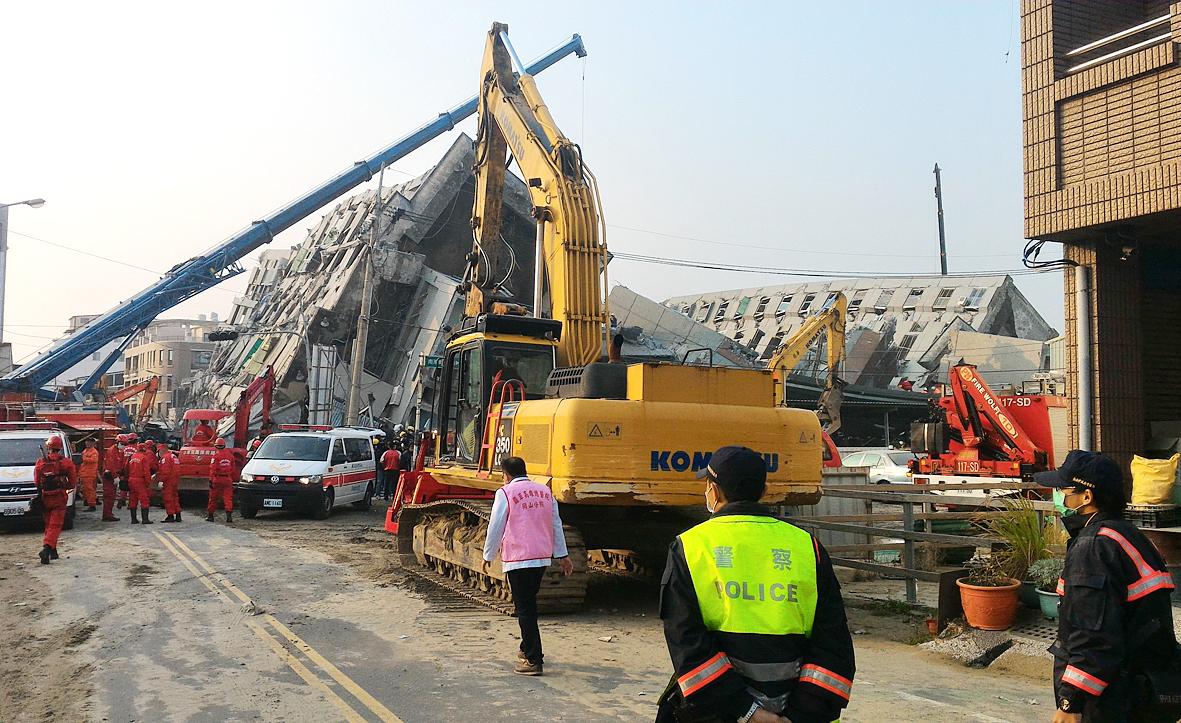
Photo: Steven Crook
The replacement pavilion, inaugurated last year, shines with fresh colors. Yet I felt slightly disappointed. Those in charge of the rebuilding project missed an opportunity to innovate. The term “McTemple” comes to mind.
In Shanshang District (山上), where part of the market fell down, the rubble was tidied away soon enough. Nothing there — not even a conspicuously new structure — now hints at a recent calamity.
In the week that followed the Feb. 6, 2016 disaster, media attention focused on the Weiguan Jinlong Apartment Complex in Yongkang District, where rescuers were trying to extricate survivors.
The 21-year-old, 17-floor complex fell southeast across Yongda Road Section 2 (永大路二段), obliterating a small commercial building on the other side of the thoroughfare.
The death toll at Weiguan Jinlong Apartment Complex was 115. Lawsuits brought by the authorities and victims dragged into last year, but there was never any serious doubt that design flaws and the use of inferior materials had caused the building’s catastrophic failure.
Approaching the site two days after the quake, my jaw dropped. However many disaster movies and however much TV coverage you’ve seen, seeing an entire apartment block lying on its side in real life is truly something else.
After the ruins of Weiguan Jinlong Apartment Complex were cleared, the city government decided to build a new residential block. The 47-apartment Chuyun Condominiums (出雲居) is on schedule for completion by the end of this year.
Tainan is famous for its ancient and fabulously ornate temples, and two of these landmarks sustained serious damage.
DAMAGED TEMPLES
At the Wind God Temple (風神廟) on Lane 143, Minquan Road Section 3 (民權路三段), one of the two 18th-century stone pavilions collapsed. It’s since been reconstructed using a mix of original and brand-new blocks. This wasn’t the first time it’s been reassembled — until Kangle Street (康樂街) was widened in the 1980s, the tower stood approximately 3m east of its current location.
Cracks appeared in the roof and in some of the columns at the Martial Rites Temple (祀典武廟), on the corner of Yongfu Road (永福路) and Minzu Road (民族路).
Post-quake repairs were finished a while ago, but now those in charge are dealing with a different issue. The altar to the Jade Emperor (玉皇大帝) — the first visitors see after they enter the temple — has been moved forward, so a serious termite problem can be treated.
The Martial Rites Temple used to be part of the palace of Prince Ning Jing (寧靖王), the Ming dynasty pretender who arrived in Tainan with the forces of Cheng Cheng-kung (鄭成功, also known as Koxinga). It continued as a shrine dedicated to Guan Gong (關公), the Chinese god of war and martial arts, through the subsequent periods of Qing, Japanese and KMT rule.
Nowadays, the Martial Rites Temple deserves its place on the tourist trail. It’s an atmospheric blend of timeworn antiquity and living, breathing faith.
When I was there last week, I was surprised to notice that almost all of the younger visitors had sticks of incense, rather than smartphones, in their hands. Then again, in a country where natural disasters are alarmingly frequent, seeking a bit of divine protection is understandable.
Steven Crook has been writing about travel, culture and business in Taiwan since 1996. He is the author of Taiwan: The Bradt Travel Guide and co-author of A Culinary History of Taipei: Beyond Pork and Ponlai.

Climate change, political headwinds and diverging market dynamics around the world have pushed coffee prices to fresh records, jacking up the cost of your everyday brew or a barista’s signature macchiato. While the current hot streak may calm down in the coming months, experts and industry insiders expect volatility will remain the watchword, giving little visibility for producers — two-thirds of whom farm parcels of less than one hectare. METEORIC RISE The price of arabica beans listed in New York surged by 90 percent last year, smashing on Dec. 10 a record dating from 1977 — US$3.48 per pound. Robusta prices have
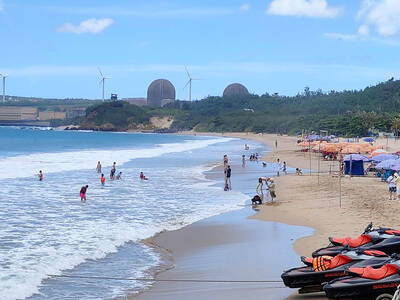
A dozen excited 10-year-olds are bouncing in their chairs. The small classroom’s walls are lined with racks of wetsuits and water equipment, and decorated with posters of turtles. But the students’ eyes are trained on their teacher, Tseng Ching-ming, describing the currents and sea conditions at nearby Banana Bay, where they’ll soon be going. “Today you have one mission: to take off your equipment and float in the water,” he says. Some of the kids grin, nervously. They don’t know it, but the students from Kenting-Eluan elementary school on Taiwan’s southernmost point, are rare among their peers and predecessors. Despite most of
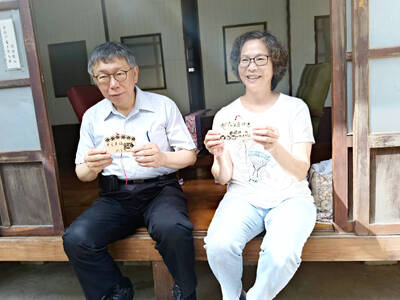
The resignation of Taiwan People’s Party (TPP) co-founder Ko Wen-je (柯文哲) as party chair on Jan. 1 has led to an interesting battle between two leading party figures, Huang Kuo-chang (黃國昌) and Tsai Pi-ru (蔡壁如). For years the party has been a one-man show, but with Ko being held incommunicado while on trial for corruption, the new chair’s leadership could be make or break for the young party. Not only are the two very different in style, their backgrounds are very different. Tsai is a co-founder of the TPP and has been with Ko from the very beginning. Huang has

Nine Taiwanese nervously stand on an observation platform at Tokyo’s Haneda International Airport. It’s 9:20am on March 27, 1968, and they are awaiting the arrival of Liu Wen-ching (柳文卿), who is about to be deported back to Taiwan where he faces possible execution for his independence activities. As he is removed from a minibus, a tenth activist, Dai Tian-chao (戴天昭), jumps out of his hiding place and attacks the immigration officials — the nine other activists in tow — while urging Liu to make a run for it. But he’s pinned to the ground. Amid the commotion, Liu tries to